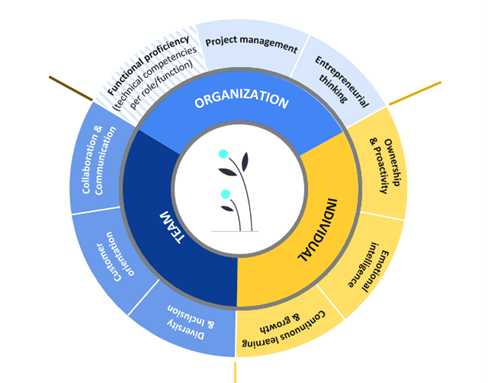Whenever we meet people, we unconsciously form a picture of ‚how‘ someone is and how they will act. So we do diagnostics. And in almost every professional people process in companies, diagnostics is somehow the basis. And when strategies fail, it is often due to human behavior.
However, very few companies deal with diagnostics professionally – and it’s not that difficult.
A great amount of instruments …
What makes it a little more difficult is to categorize the multitude of diagnostic tools on the market. In addition to the over-the-counter ones, there are also in-house developments from the major consultancies.
How practicable are these instruments?
And isn’t a person’s personality far too complex to be described in just a few dimensions? Aren’t we pigeonholing ourselves and isn’t that harmful?
I have had experience with a variety of instruments and consider many of them to be legitimate if they are introduced properly (and their limits are pointed out!) and are not taken too seriously, but are used as a language to talk about personality within the company. Nothing more.
…in a nutshell:
Hogan Assessments
is a battery of ‚hard‘ personality diagnostic instruments. At their core, they are based on the Big5 model – which is generally the only truly recognized model in psychology. The Hogan test is like the big blood count, it is expensive and always needs a certified expert to explain the results. But then it is more informative than almost any other instrument when it comes to predicting behavior on the job. It is not for nothing that almost all major headhunters use Hogan Assessments.
Other scientifically proven instruments, such as Zenger Folkman’s Leadership Competencies or the Leadership Circle, are also suitable for leadership style analyses. Most of the instruments used by the major search firms work in a similar way.
DISCinsights, HBDI®, MBTI® are contingency models that are based on theoretical assumptions about personality and manage to reduce personality to a few dimensions. The scientific basis is somewhat thinner than with the Big5 – but I consider these instruments to be at least evident enough to use them in practice with restrictions – as a language and at least to recognize that people are different. This is how they should be introduced.
The Predictive Index (PI) is a special feature: A very easy-to-use tool that, with a test lasting just 6 minutes, delivers surprisingly clear results. Even non-experts can understand the model in just a few hours of training and can then work with it. The PI therefore also offers a portfolio of instruments, such as job profiles, based on the PI.
The bridge to culture
In addition to individual behavioural preferences, it usually makes sense to take a look at the culture of an organization: Where do we stand? Where do we want to go? Where do we need to change? Who fits in with us? Motives and values play an important role here. The Hogan has incorporated such a test on individual values and motives. But there are also two other models that I would like to point out explicitly:
The Reiss Profile® and the 9Levels test:
These are also based on models of life motives (Reiss) or maturity levels of value development (9Levels). Recognizing such preferences in coaching, for example, and perhaps discussing them in a team can be very helpful. However, the 9Levels can also be applied to teams and entire organizations, allowing measures for cultural development to be derived. Large consultancies often use their own procedures for this. SpencerStuart, for example, uses an integrated instrument that correlates the personality and values/culture of a candidate and an organization.
Customized competency models:
In order to analyze and understand, personality models and tests are useful and important.
However, they fall short when it comes to justifying long-term transformations or building systematic personnel development on them.
There is another diagnostic approach here:
If you need a real basis for recruiting in order to address and select the right candidates, to create development and training plans or to initiate a transformation, a simple psychological ‚contingency model‘ is not sufficient. It then makes sense to develop a customized competency model for the company. Personality dimensions, values or motives and culture can also play a role here. If a personality model is to be used as the basis for the core competencies for each position, specialist advice is required. This is because the development of a competency model is a project in which professional competencies are also classified/grouped into a few, scalable and comprehensible categories, taking into account the respective corporate strategy, vision, mission statement, mission and values. This is precisely why a competency model can hardly be standardized – because every company is different.
Once a company-specific competency model has been developed, it can become the ‚language‘ of the company over time when feedback is given or performance or potential is discussed with employees. The competency model can also point in a cultural direction and pave the way for more agility or more self-organization.
Competency-based HR work
A well-designed competency model can also be used for succession planning or training planning. At the same time, it can even be the basis for a very modern job evaluation or compensation & benefit system.
Together with the Comp&Ben consultancy Lurse, we have developed some very innovative concepts for this.

Based on competency models, we have also developed and conducted customized interview training for managers (and teams). In my opinion, it has the greatest effect if the right competencies are already taken into account when selecting new employees – and this includes in particular the personality, values and motives (‚mindset‘) of the applicants. In my experience, a well-coordinated team of interviewers with competency models for evaluation beats any personality test!
Audits – tailor-made
In addition to transformation projects, company mergers are an important landmark event for which diagnostics can be extremely useful. These audits are usually carried out by search firms using their own instruments. In my opinion, it is often criminally underestimated to use a competency model that maps the company’s new strategy in order to see which employees can help shape the new. Culture eats strategy. We have a few very positive examples of how it can be done better (and cheaper) with the targeted use of validated tests.
Finally, I would like to tell you that diagnostics, when used correctly, do not hurt, but that most people love to be ‚recognized‘ and to ’see‘ other people in a more differentiated way. Whether it’s a competency model or a personality test – in my experience, such projects always have a positive effect on collaboration, feedback culture and fun at work.
At Breitenstein, we are experts in diagnostics and would be happy to help you too.




